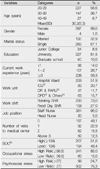1. Antonovsky A. Unraveling the mystery of health: how people manage stress and stay well. 1987. San Francisco: Jossey-Bass.
2. Basińska MA, Andruszkiewicz A, Grabowska M. Nurses' sense of coherence and their work related patterns of behaviour. Int J Occup Med Environ Health. 2011. 24(3):256–266.

3. Bengtsson-Tops A, Hansson L. The validity of Antonovsky's sense of coherence measure in a sample of schizophrenic patients living in the community. J Adv Nurs. 2001. 33(4):432–438.

4. Binkowska-Bury M, Januszewicz P. Sense of coherence and health-related behaviour among university students-a questionnaire survey. Cent Eur J Public Health. 2010. 18(3):145–150.

5. Chang EM, Bidewell JW, Huntington AD, Daly J, Johnson A, Wilson H, et al. A survey of role stress, coping and health in Australian and New Zealand hospital nurses. Int J Nurs Stud. 2007. 44(8):1354–1362.

6. Chang SJ. Standardization of collection and measurement of health statistics data. 2000. Seoul, Korea: The Korean Society for Preventive Medicine;92–143.
7. Chang SJ, Koh SB, Kang DM, Kim SA, Kang MG, Lee CG, et al. Developing an occupational stress scale for Korean employees. Korean J Occup Environ Med. 2005. 17(4):297–317.

8. Delgado C. Sense of coherence, spirituality, stress and quality of life in chronic illness. J Nurs Scholarsh. 2007. 39(3):229–234.

9. Eriksson M, Lindström B. Validity of Antonovsky's sense of coherence scale: a systematic review. J Epidemiol Community Health. 2005. 59(6):460–466.

10. Eriksson M, Lindström B. A salutogenic interpretation of the Ottawa charter. Health Promot Int. 2008. 23(2):190–199.

11. Erim Y, Beckmann M, Kroencke S, Schulz KH, Tagay S, Valentin-Gamazo C, et al. Sense of coherence and social support predict living liver donors' emotional stress prior to living-donor liver transplantation. Clin Transplant. 2008. 22(3):273–280.

12. Flensborg-Madsen T, Ventegodt S, Merrick J. Why is Antonovsky's sense of coherence not correlated to physical health? analysing Antonovsky's 29-item sense of coherence scale(SOC-29). ScientificWorldJournal. 2005. 14(5):767–776.
13. Fok SK, Chair SY, Lopez V. Sense of coherence, coping and quality of life following a critical illness. J Adv Nurs. 2005. 49(2):173–181.

14. Haas BK. A multidisciplinary concept analysis of quality of life. West J Nurs Res. 1999. 21(6):728–742.

15. Haoka T, Sasahara S, Tomotsune Y, Yoshino S, Maeno T, Matsuzaki I. The effect of stress-related factors on mental health status among resident doctors in Japan. Med Educ. 2010. 44(8):826–834.

16. Kim HC, Kwon KS, Koh DH, Leem JH, Park SG, Shin JY, et al. The relationship between job stress and psychosocial stress among nurses at a university hospital. Korean J Occup Environ Med. 2005. 18(1):25–34.

17. Kim SS, Park JS, Roh YS. The relationship of individual characteristics, perceived health status, body image, and health promoting behavior in hospital nurses. J Korean Acad Adult Nurs. 2005. 17(1):88–99.
18. Koh SB, Son MA, Kong JO, Lee CG, Chang SJ, Cha BS. Job characteristics and psychosocial distress of atypical workers. Korean J Occup Environ Med. 2004. 16(1):103–113.

19. Lerdal A, Andenæs R, Bjørnsborg E, Bonsaksen T, Borge L, Christiansen B, et al. Personal factors associated with health-related quality of life in persons with morbid obesity on treatment waiting lists in Norway. Qual Life Res. 2011. 20(8):1187–1196.

20. Lee EH, Chang SJ, Kim HO, Roh JH, Park EJ, Won JU. Relationship between job stress and turnover of registered nurses in a university hospital. Korean J Occup Environ Med. 2007. 19(2):93–103.

21. NIOSH. DHHS (NIOSH) Publication No. 99-101. Stress at work. 1999. America:
22. Norekvål TM, Fridlund B, Moons P, Nordrehaug JE, Saevareid HI, Wentzel-Larsen T, et al. Sense of coherence-a determinant of quality of life over time in older female acute myocardial infarction survivors. J Clin Nurs. 2010. 19(5-6):820–831.

23. Park JS. Factors influencing on burnout experience in working nurses at hospital. Korean J Women Health Nurs. 2002. 8(4):550–558.

24. Park JS, Seo IS, Oh JA, Choi ES. Sense of coherence and coping resources of working Nurses at hospital. Korean J Women Health Nurs. 2001. 7(3):348–358.

25. Seo IS. A study on the sense of coherence and compliance in patients with diabetes mellitus. 2002. Seoul: Catholic University;Unpublished master's thesis.
26. Ware JE, Kosinski M, Dewey JE. How to score version 2 of the SF-36 health survey(Standard & Acute forms). 2000. Lincoln, RI: QualityMetric Incorporated.
27. Yoon CK, Lee HN. A study on the job stress of nurses in hospital. J Korean Soc Health Stat. 2003. 28(2):95–109.
28. Yoon GS, Kim SY. Influence of job stress and burnout on turnover intention of nurses. J Korean Acad Nurs Adm. 2010. 16(4):507–516.

29. Yoon HS, Cho YC. Relationship between job stress contents, psychosocial factors and mental health status among university hospital nurses in Korea. J Prev Med Public Health. 2007. 40(5):351–362.

30. Yoon SH. Occupational stress and depression in clinical uurses-using Korean occupational stress scales-. J Korean Acad Nurs Adm. 2009. 15(3):463–470.








 PDF
PDF ePub
ePub Citation
Citation Print
Print







 XML Download
XML Download